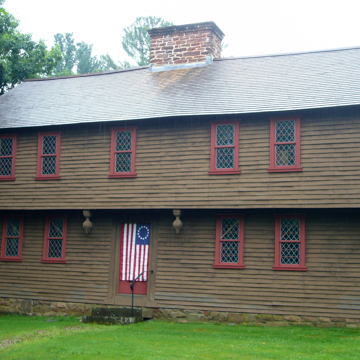The Stanley-Whitman House is one of the New England’s earliest extant wood frame structures and is a fine example of the colonial saltbox house. Located on High Street (originally Back Lane), just east of what became Farmington Village’s Main Street, the house was built for John Stanley, deacon of the First Congregational Church, on land bequeathed from his father. It is unlikely that Stanley ever lived in the house, however, as the property was purchased by Ebenezer Steel in December 1720. Steele’s daughter, Mary, and her husband, Thomas Smith, occupied the house after Steele’s death in 1722. They were succeeded by Solomon and Susannah Cole Whitman as owners of the property.
One of the house’s most prominent features is its overhanging upper story derived from English medieval construction techniques. The Stanley-Whitman House features a so-called “true” overhang in which separate framing members form the two different facade planes (with one post set from sill to girt and a second from girt to plate). This framing techniques allows for a much deeper projection—here eighteen inches. The upper-floor posts project beneath the second-floor girt and are carved into pendants and exposed as a decorative exterior feature, known as carved drops. There are four drops, with two located at the corners of the overhang and two on either side of the central entrance. While some of the original riven weatherboard siding survives, much has been replaced over time. Two casement windows placed just under the overhang are located on either side of the central door, with matching windows on the second story. An off-center window is located above the door on the second level. The diamond-paned casement windows are replacements modeled after the originals.
The house features a two-room plan (parlor and hall) around a central field- and sandstone chimney, with two chambers on the second level and an attic space above. The front entry door leads to a small porch room with a stairway to the second level. The lean-to addition was added sometime around the mid-eighteenth century, at which time the chimney was rebuilt and the roof pitch lowered to accommodate the addition, creating the single pitch of the saltbox form. The lean-to consists of a central kitchen space with a small rooms at either end of the kitchen. Openings created at the rear of the original structure provide access to this kitchen. An ell added to the house around 1760 was rebuilt during a 1934 restoration by J. Frederick Kelly. Due to Kelly’s erroneous belief that the house was constructed in 1660, some alterations completed were not necessarily appropriate for the early-eighteenth-century building.
In 1935, the same year as the Connecticut tercentenary, local philanthropist D. Newton Barney donated the house and a $35,000 trust to the Farmington Village Green and Library Association to open a history museum. The exhibits display period antiques to reflect the everyday activities of colonial life in Connecticut. The organization purchased additional land in 1941, bringing the property to its current size. The house was designated a National Historic Landmark in 1960 and underwent another restoration in 1988. The museum expanded in 2004 with an L-shaped addition at the rear of the house, which accommodates a new visitors’ center, classroom space, a period tavern room, research library, exhibit gallery, and storage area. The property is surrounded by a low stone wall and features an orchard and raised bed garden.
References
Dillon, James, “Stanley-Whitman House,” Hartford County, Connecticut. National Register of Historic Places Inventory–Nomination Form, 1974. National Park Service, U.S. Department of the Interior, Washington, D.C.
“Farmington Village Green and Library Association.” Farmington Libraries. Accessed June 9, 2021. https://farmingtonlibraries.org/.
Kelly, J. Frederick. Architectural Guide for Connecticut. New Haven: Yale University Press, 1935.
Morrison, Hugh. Early American Architecture, From the First Colonial Settlements to the National Period. New York: Dover, 1952.

